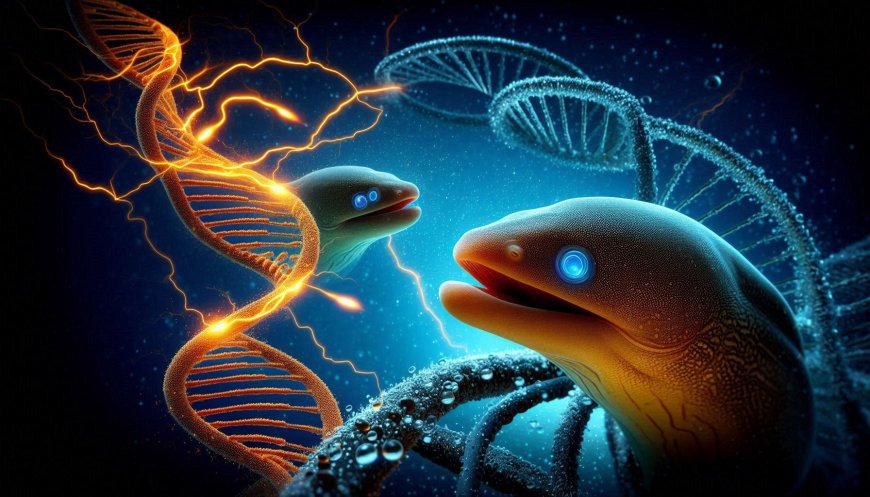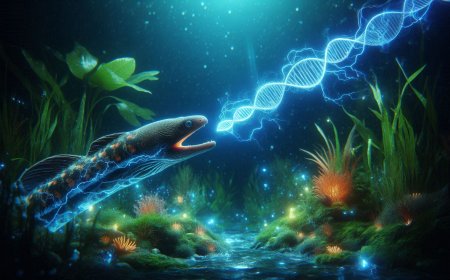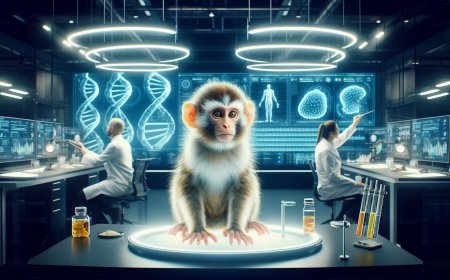Did You Know That Electric Eels Can Be Natural Gene Editors?
Did you know electric eels can naturally edit genes? A groundbreaking study by Nagoya University reveals that electric eels can use their shocks to transfer DNA to fish larvae through natural electroporation, changing genetics in the wild.

In a remarkable discovery that blurs the lines between biology and biotechnology, researchers at Nagoya University in Japan have found that electric eels can naturally perform gene editing—a process typically reserved for high-tech laboratory settings. This groundbreaking finding reveals that electric eels use their powerful electric discharges to transfer genetic material to nearby fish larvae, effectively altering their DNA in a phenomenon scientists are calling natural electroporation.
⚡ What Is Electroporation?
Before diving into the eel’s shocking secret, it's important to understand electroporation. In laboratories, electroporation is a widely-used technique where a brief electrical pulse is applied to cells. This pulse opens temporary pores in the cell membranes, allowing foreign DNA or molecules to pass through. Once the pores close, the introduced genetic material becomes part of the cell’s internal environment and can integrate into its genetic code.
Until now, electroporation was believed to occur only in controlled lab conditions using specialized equipment. But nature, as it turns out, may have been using this tool all along.
⚡ The Shocking Discovery at Nagoya University
A team of biologists led by researchers at Nagoya University observed something fascinating while studying interactions between electric eels (Electrophorus electricus) and their surrounding environment. The eels, known for delivering electric shocks as strong as 600 volts, were kept in proximity to zebrafish larvae—a common species used in genetic research.
The researchers introduced fluorescent DNA markers into the water. To their surprise, zebrafish larvae that were exposed to eel shocks absorbed the genetic material and began expressing the introduced DNA—essentially becoming genetically modified as a direct result of the eel’s electric shock.
This event marked the first known natural instance of electroporation occurring in the wild without human intervention or laboratory tools.
⚡ How Does This Work?
The process is relatively simple, but deeply profound in its implications:
1. Eel Delivers a Shock: The electric eel emits a high-voltage shock, usually to stun prey or defend itself.
2. Cell Membranes Open: Nearby organisms, like fish larvae, experience a temporary disruption in their cell membranes—just like in artificial electroporation.
3. DNA Transfers: Genetic material present in the water—whether naturally occurring or artificially introduced—enters the open cells.
4. Genes Are Altered: Once the membranes close, the new genetic material can become integrated into the host’s genome.
⚡ Implications of Natural Electroporation
This discovery has opened up new frontiers in evolutionary biology, genetics, and environmental science:
- Natural Genetic Transfer: It suggests that gene transfer between species in aquatic environments may occur more frequently than previously thought.
- Evolutionary Impact: Electric eels might influence the evolution of nearby organisms, altering traits across generations through repeated exposure.
- New Genetic Tools: It raises the possibility of developing eco-friendly gene editing techniques inspired by natural mechanisms.
- Ecological Considerations: Understanding this process could help us explore how pollution, DNA in runoff, or other environmental factors might unintentionally alter wildlife genetics.
⚡ Nature: The Ultimate Biotechnologist?
Nature continues to surprise us with its ingenuity. The ability of electric eels to act as natural gene editors is a potent reminder that many laboratory discoveries are often reflections of natural phenomena yet to be fully understood.
As Dr. Yasuyuki Nakamura, one of the lead researchers, put it:
"This study reminds us that nature has always been ahead of us in finding elegant solutions to complex biological problems. We are merely catching up."
⚡ Final Thoughts
From CRISPR to electroporation, science often looks to nature for inspiration. The revelation that electric eels can spontaneously and naturally edit the genes of nearby organisms challenges our understanding of genetic boundaries and showcases yet another example of the hidden wonders of the natural world.
So the next time you hear about gene editing or marvel at lab breakthroughs, remember—an electric eel might have been doing it in the wild all along.
What's Your Reaction?






































































































